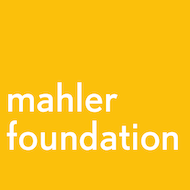Address: Simmeringer Hauptstrasse 230-244, Vienna 1110, Austria.
The Zentralfriedhof (Central Cemetery, Zentral Friedhof) is one of the largest cemeteries in the world, largest by number of interred in Europe and most famous cemetery among Vienna’s nearly 50 cemeteries.The cemetery’s name is descriptive of its significance as Vienna’s biggest cemetery, not of its geographic location, as it is not situated in the city center of the Austrian capital, but on the outskirts, in the outer city district of Simmering.
Reference: Gustav Mahler (1860-1911) (GM).
There are 4 cemeteries (from left to right, east to west, along the Simmeringer Hauptstrasse):
Cemetery 4: New Jewish cemetery (Gate 4)
- Josef Lowy (1834-1902) (Old or New Jewish cemetery). GM aged 42.
- Heinrich Friedjung (1851-1920) (7-27-12). GM died 9 years ago.
- Ludwig Elias Quittner (1858-1922) (10-1-18). GM died 11 years ago. (Family)
- Leo Fall (1873-1925) (3-4-1). GM died 14 years ago.
- Elise Elizza (1870-1926) (3-4-3). GM died 15 years ago.
- Julius Epstein (1832-1926) (3-4-2). GM died 15 years ago.
Cemetery 3: Evangelical cemetery (Gate 3)
- Alfred Roller (1864-1935) (5-40/41). GM died 24 years ago.
- Franz Naval (1865-1939) (9-1-36). GM died 28 years ago.
- Emilie Louise Floge (1874-1952) (8 + Allee 4). GM died 41 years ago.
Cemetery 2: Central cemetery (Gate 2)
Died before Gustav Mahler (1860-1911) was born:
- Christoph Willibald von Gluck (1714-1787) (32A-49). Died 73 year before GM was born.
- Ludwig van Beethoven (1770-1827) (32A-29). Died 33 year before GM was born.
- Franz Schubert (1797-1828) (31A-28). Died 32 year before GM was born.
Died during the life of Gustav Mahler (1860-1911):
- Moriz Grunfeld (1819-1882) (IFR). GM aged 22.
- Jakob Emil Schindler (1842-1892) (14A-51). GM aged 32. (Family)
- Hans Rott (1858-1884) (23-2-59). GM aged 24 and attended the funeral.
- Theodor Billroth (1829-1894) (14A-7). GM aged 34.
- Franz von Suppe (1819-1895) (32A-31). GM aged 35.
- Johannes Brahms (1833-1897) (32A-26). GM aged 37.
- Carl Zeller (1842-1898) (47B-G1-9). GM aged 38.
- Johan Jr. Strauss (1825-1899) (32A-27). GM aged 39 and attended the funeral.
- Carl Millocker (1842-1899) (32A-35). GM aged 39.
- Wilhelm Jahn (1835-1900) (0-1-26). GM aged 40.
- Julius Victor Berger (1850-1902) (14A-8). GM aged 42. (Family)
- Hugo Wolf (1860-1903) (32A-10). GM aged 43 and attended the funeral.
- Anton Ruckauf (1855-1903) (32A-12). GM aged 43.
- Eduard Hanslick (1825-1904) (18-1-9). GM aged 44.
- August Plappart von Leenheer (1836-1907) (14-B-34). GM aged 47.
- Max Josef Beer (1851-1908) (72D-G1-31). GM aged 48.
- Karl Lueger (1844-1910) (Crypt 5 Borromeo Church). GM aged 50.
- Leopold Demuth (1861-1910) (33H-7-7). GM aged 50.
Died after the death of Gustav Mahler (1860-1911):
- Karl Wittgenstein (1847-1913) (32B-24). GM died 2 years ago.
- Josef Bayer (1852-1913). (0-1-66). GM died 2 years ago.
- Karl Goldmark (1830-1915) (52A-1-13). GM died 4 years ago.
- Victor Adler (1852-1918) (24-5-1A). GM died 7 years ago.
- August Stoll (1853-1918) (59-A-8-23). GM died 7 years ago.
- Engelbert Pernerstorfer (1850-1918) (24-5-1A). GM died 7 years ago.
- Ludwig Bosendorfer (1835-1919) (17B-G1-10). GM died 8 years ago.
- Natalie Bauer-Lechner (1858-1921) (59B-G1-21). GM died 10 years ago.
- Karl Michael Ziehrer (1843-1922) (32C-1). GM died 11 years ago.
- Heinrich Berte (1858-1924) (59A-6-16). GM died 13 years ago.
- Ferdinand Lowe (1863-1925) (31B-13-9). GM died 14 years ago.
- Rudolf Pichler (1856-1925) (84-10-41). GM died 14 years ago.
- Karl Horwitz (1884-1925) (41-B-G1-36). GM died 14 years ago.
- Grafin Maria Misa von Wydenbruck-Esterhazy (1859-1926). (55-B-23). GM died 15 years ago.
- Gerhard Stehmann (1866-1926) (17-1-22). GM died 15 years ago.
- Franz Neidl (1855-1926) (120-5-22). GM died 15 years ago.
- Robert Fuchs (1847-1927) (33E-3-5). GM died 16 years ago.
- Albine Adler (1870-1927) (67-46-86). GM died 16 years ago.
- Hermann Theodor Gradener (1844-1929) (47F-12-7). GM died 18 years ago.
- Selma Kurz (1874-1933) (14C-8). GM died 22 years ago.
- Adolf Loos (1870-1933) (0-1-105). GM died 22 years ago.
- Richard Ritter von Meyrswalden Kralik (1852-1934) (14C-9). GM died 23 years ago.
- Mathilde Frohlich (1865-1934) (67-44-86). GM died 23 years ago.
- Georg Reimers (1860-1936) (32C-11). GM died 25 years ago.
- Karl Kraus (1874-1936) (5A-1-33). GM died 25 years ago.
- Ludwig Karpath (1866-1936) (30D-1-7). GM died 25 years ago.
- Guido Adler (1855-1941) (32C-51). GM died 30 years ago.
- Josef Anton Engelhart (1864-1941) (16H-1). GM died 30 years ago.
- Wilhelm Kienzl (1857-1941) (32C-20). GM died 30 years ago.
- Alexander von Zemlinsky (1871-1942) (33G-71). GM died 31 years ago.
- Margarethe (Grete) Julie Schindler (1881-1942) (41A-G2-7). GM died 31 years ago. (Family)
- Margaretha Rita Merlitschek-Michalek (1875-1944) (160-10-55). GM died 33 years ago.
- Franz Werfel (1890-1945) (32C-39). GM died 34 years ago.
- Hans Pfitzner (1869-1949) (14C-16). GM died 38 years ago.
- Wilhelm Legler (1875-1951) (41A-G2-7). GM died 40 years ago. (Family)
- Arnold Schoenberg (1874-1951) (32C-21A). GM died 40 years ago.
- Josef Hoffmann (1870-1956) (14C-20). GM died 45 years ago.
- Wilhelm (Willy) Carl Emil Legler (1902-1960). (41A-G2-7) GM died 49 years ago. (Family)
- Joseph Marx (1882-1964) (32C-29). GM died 53 years ago.
- Grete Wiesenthal (1885-1970) (55-A-13). GM died 59 years ago.
- Egon Wellesz (1885-1974) (32C-38). GM died 63 years ago.
- Robert Stolz (1880-1975) (32C-24). GM died 64 years ago.
- Lotte Lehmann (1888-1976) (32C-49). GM died 65 years ago.
- Ernst Krenek (1900-1991) (33G-1). GM died 80 years ago. (Family)
Cemetery 1: Old Jewish cemetery (Gate 1)
- Leopoldine Quittner-Mahler (1863-1889) (8-5-59). GM aged 29. (Family)
- Otto Mahler (1873-1895) (20-19-35). GM aged 35. (Family)
- Karl Goldmark (1830-1915) (52A-1-13). GM died 4 years ago.
- Armin Czinner (1853-1918) (6-4-43). GM died 7 years ago.
- Joseph Sulzer (1850-1926) (grave?). GM died 15 years ago.
- Emil Freund (1858-1928) (76B-34-3). GM died 17 years ago.
- Arthur Schnitzler (1862-1931) (6-0-4). GM died 20 years ago.
- Friedrich Torberg (1908-1979) and Marietta Torberg (1920-2000) (6-0-3). GM died 68 years ago.
Central cemetery. General situation. From Gates 4, 3, 2 and 1 you go in Southern direction. Take maps and a compass with you. Very stretched out.
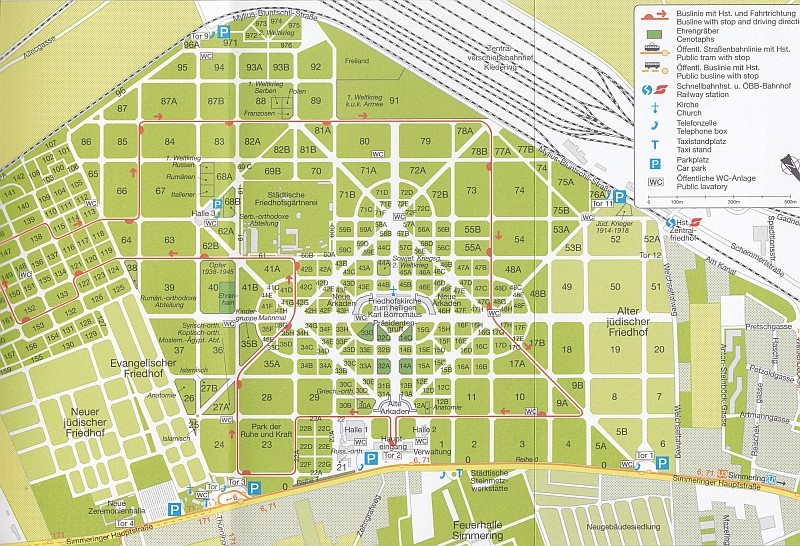
Vienna, Central cemetery, Map overview 4 cemeteries from left to right:
- Cemetery 4: New Jewish cemetery (Gate 4).
- Cemetery 3: Evangelical cemetery (Gate 3).
- Cemetery 2: Central cemetery (Gate 2).
- Cemetery 1: Old Jewish cemetery (Gate 1).
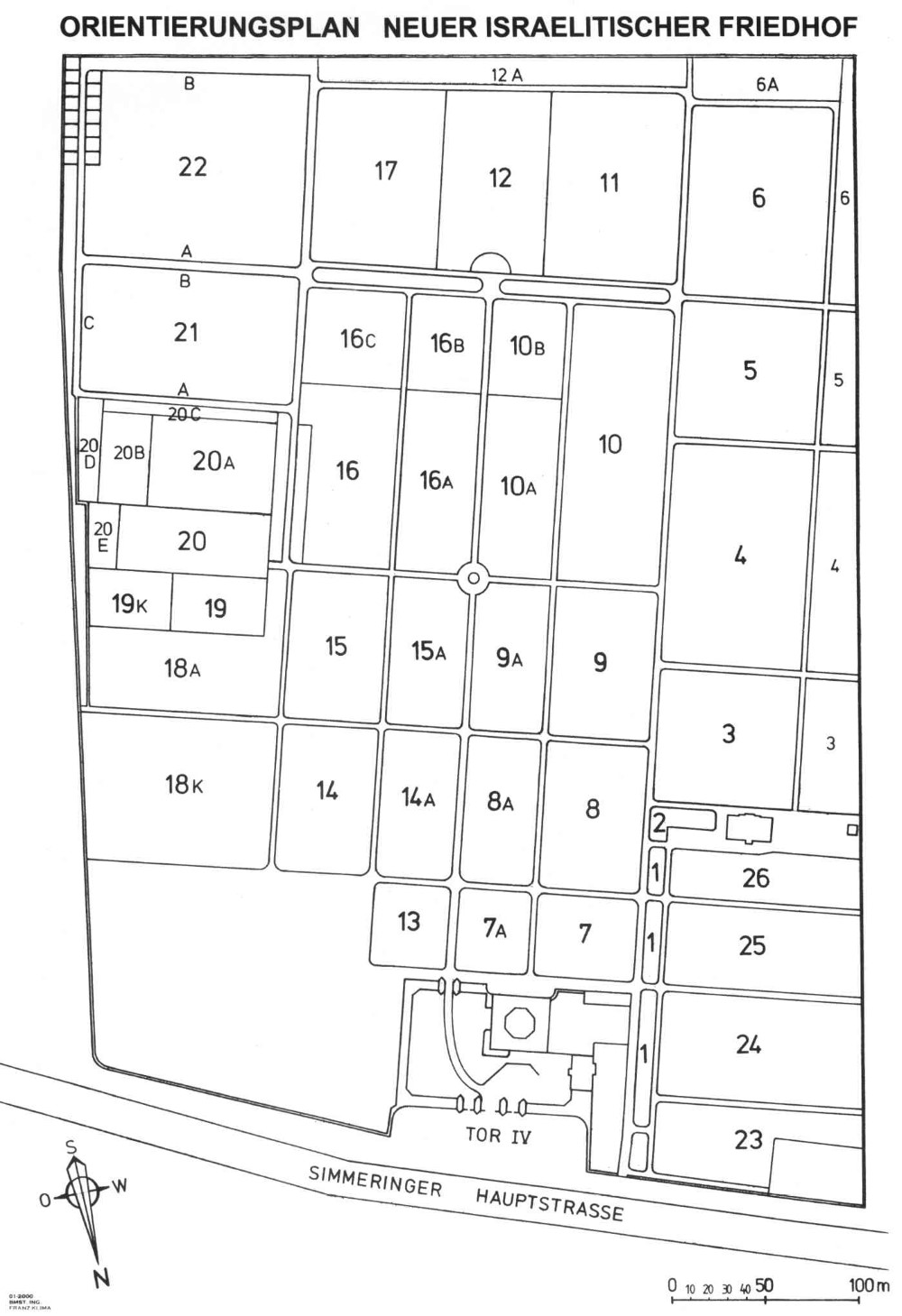
Vienna, Central cemetery, Map 1/2 cemetery 4: New Jewish cemetery (Gate 4).
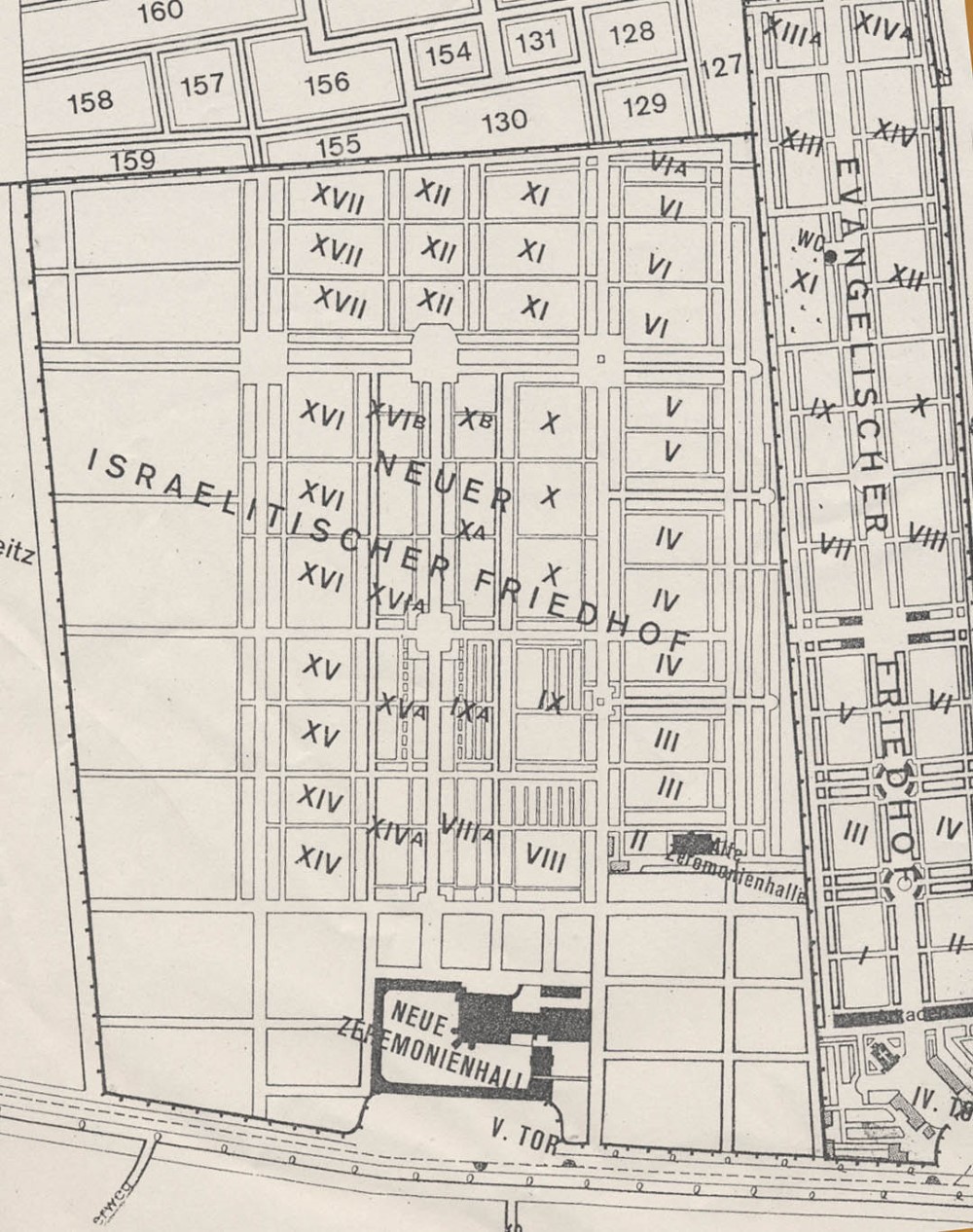
Vienna, Central cemetery, Map 2/2 cemetery 4: New Jewish cemetery (Gate 4).
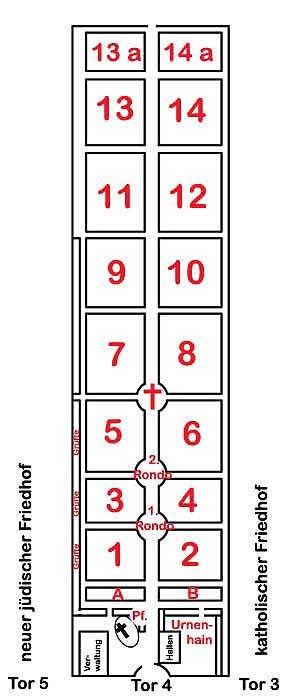
Vienna, Central cemetery, Map cemetery 3: Evangelical cemetery (now Gate 3).
Vienna, Central cemetery, Map cemetery 2: Central cemetery (Gate 2).
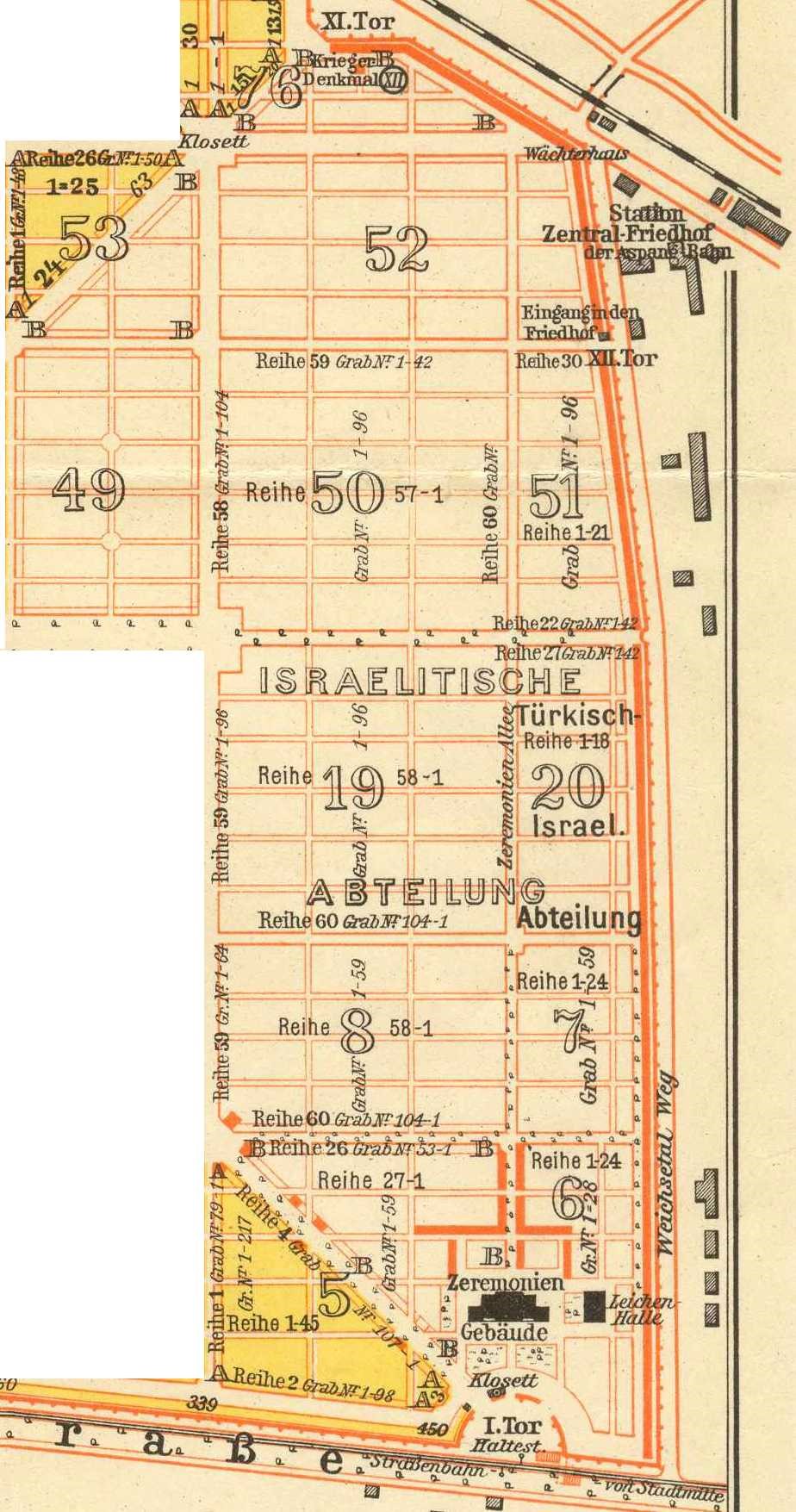
Vienna, Central cemetery, Map cemetery 1: Old Jewish cemetery (Gate 1).
Vienna, Central cemetery, Map cemetery 1: Old Jewish cemetery (Gate 1).
Unlike many others, the Vienna Central Cemetery is not one that has evolved slowly with the passing of time. The decision to establish a new, big cemetery for Vienna came in 1863 when it became clear that – due to industrialisation – the city’s population would eventually increase to such an extent that the existing communal cemeteries would prove insufficient.
City leaders expected that Vienna, then capital of the large Austro-Hungarian Empire, would grow to four million inhabitants by the end of the 20th century, as no one foresaw the Empire’s collapse in 1918. The city council therefore assigned an area significantly outside of the city’s borders and of such a gigantic dimension, that it would suffice for a long time to come. They decided in 1869 that a flat area in Simmering should be the site of the future Zentralfriedhof. The cemetery was designed in 1870; according to the plans of the Frankfurt landscape architects Karl Jonas Mylius and Alfred Friedrich Bluntschli who were awarded for their project per angusta ad augusta (from dire to sublime).
Opened All Saint’s Day 1874, far outside Vienna’s city borders. However the consecration of the cemetery was not without controversy: the interdenominational character of the new cemetery – the different faith groups being interred on the same ground – met with fierce resistance, of course, especially in conservative circles of the Roman Catholic Church.
This argument became even more aggressive when the city announced that it did not want an official Catholic opening of the new cemetery – but gave a substantial amount of money toward the construction of a segregated Jewish section. In the end, the groups reached an agreement and the Catholic representatives opened the Zentralfriedhof with a small ceremony, refraining from a large public show. So the new cemetery was inaugurated almost unnoticed in the early morning hours 31 October 1874, by Vienna Mayor Baron Cajetan von Felder and Cardinal Joseph Othmar Rauscher to avoid an escalation of the public controversy.
The official opening of the Central Cemetery occurred the following day. The first burial was that of Jacob Zelzer, followed by 15 others that day. The grave of Jacob Zelzer still exists near the administration building at the cemetery wall.
The cemetery spans 2.5 km2 (620 acres) with 330,000 interments and up to 25 burials daily. It is also second largest cemetery, after the 4 km2 (990 acres) of Hamburg’s Ohlsdorf Cemetery, largest in Europe by number of interments and area.
Ehrengräber (Honorary graves)
In its early incarnations, it was so unpopular due to the distance from the city center that the authorities had to think of ways to make it more attractive – hence the development of the Ehrengräber or honorary graves as a kind of tourist attraction.
Vienna is a city of music since time immemorial, and the municipality expressed gratitude to composers by granting them monumental tombs. Interred in the Zentralfriedhof are notables such as Ludwig van Beethoven; Franz Schubert, who were moved to the city in 1888; Johannes Brahms; Antonio Salieri; Johann Strauss II and Arnold Schoenberg. A cenotaph honours Wolfgang Amadeus Mozart, who is buried in nearby St. Marx Cemetery.
The interdenominational character
In addition to the Catholic section, the cemetery houses a Protestant cemetery (opened 1904) and two Jewish cemeteries.
Although the older of the two, established in 1863, was destroyed by the Nazis during the Kristallnacht, around 60,000 graves remain intact. Cemetery records indicate 79,833 Jewish burials as of 10 July 2011. Prominent burials here include those of the Rothschild family and that of the author Arthur Schnitzler.
The second Jewish cemetery was built in 1917 and is still in use today. There were 58,804 Jewish burials in the new section as of 21 November 2007. Officials discovered desecration of 43 Jewish graves in the two Jewish sections 29 June 2012, allegedly as an anti-Semitic act – the stones and slabs were toppled or damaged.
